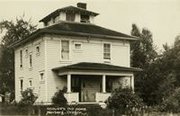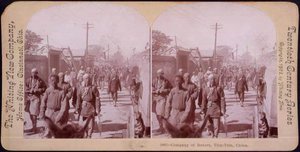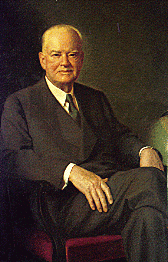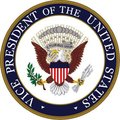Herbert Hoover
|
|
| ||
| Order: | 31st President | |
| Vice President: | Charles Curtis | |
| Term of office: | March 4, 1929 – March 4, 1933 | |
| Preceded by: | Calvin Coolidge | |
| Succeeded by: | Franklin D. Roosevelt | |
| Date of birth: | August 10, 1874 | |
| Place of birth: | West Branch, Iowa | |
| Date of death: | October 20, 1964 | |
| Place of death: | New York City, New York | |
| First Lady: | Lou Henry Hoover | |
| Political party: | Republican | |
Herbert Clark Hoover (August 10, 1874 – October 20, 1964) is best known as being the 31st (1929-1933) President of the United States. However, prior to that, he was a successful mining engineer, humanitarian, and administrator. He had the longest retirement of any U.S. President and died 31 years after leaving office, during the administration of Lyndon Johnson — his fifth successor.
| Contents |
Family background
Hoover was born into a Quaker family in West Branch, Iowa. He was the first President to be born west of the Mississippi River. Both of his parents, Jesse Hoover and Hulda Minthorn, died when Hoover was young. His father died in 1880, and his mother in 1884.
In the summer of 1885 eleven-year-old "Bert" Hoover boarded a Union Pacific train headed west to Oregon. Sewn into his clothes were two dimes; he also carried a hamper of his Aunt Hannah's homemade delicacies. Waiting for him on the other end of the continent was his Uncle John Minthorn, a doctor and school superintendent whom Hoover recalled as "a severe man on the surface, but like all Quakers kindly at the bottom." The future president lived with his uncle in Newberg, Oregon for several years following his parents' deaths.
Hoover's six years in Oregon taught him self-reliance. "My boyhood ambition was to be able to earn my own living, without the help of anybody, anywhere," he once reported. As an office boy in his uncle's Oregon Land Company he mastered bookkeeping and typing, while also attending business school in the evening. Thanks to a local schoolteacher, Miss Jane Gray, the boy's eyes were opened to the novels of Charles Dickens and Sir Walter Scott. David Copperfield, the story of another orphan cast into the world to live by his wits, would remain a lifelong favorite.
Education
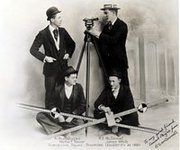
In the fall of 1891 Hoover attended the new Leland Stanford Junior University at Palo Alto, California. Cutting a wider swath outside the classroom than in, Hoover managed the baseball and football teams, started a laundry, and ran a lecture agency. Teaming up with other poor boys against campus swells, the reluctant candidate was elected student body treasurer on the "Barbarian" slate, then wiped out a student-government debt of $2,000.
Hoover earned his way through school by doing typing chores for Professor John Casper Branner, who also got him a summer job mapping the terrain in Arkansas' Ozark Mountains. It was in Branner's geology lab that he met Lou Henry, a banker's daughter born in Waterloo, Iowa, in 1874. Lou shared her fellow Iowan's love of the outdoors and self-reliant nature. "It isn't so important what others think of you as what you feel inside yourself," she told college friends.
Hoover graduated in May 1895, three months before his 21st birthday. He left Stanford with $40 in his pocket and no prospects for employment. But from this college in a hayfield he had derived much more than a degree in geology. Stanford gave Hoover an identity, a profession, and a future bride. Most of all, Stanford became for the orphan from West Branch a surrogate family--a place to belong.
In 1899 he married his Stanford sweetheart, Lou Henry. They went to China, where he worked for a private corporation as China's leading engineer. In June 1900 the Boxer Rebellion caught the Hoovers in Tianjin. For almost a month the settlement was under heavy fire. While his wife worked in the hospitals, Hoover directed the building of barricades, and once risked his life rescuing Chinese children.
Between 1907 and 1912, Lou and Hoover combined their talents to create a translation of one of the earliest printed technical treatises: Georg Agricola's De re metallica, originally published in 1556. At 670 pages with 289 woodcuts, the Hoover translation remains the definitive English language translation of Agricola's work.
Hoover's humanitarian years
Bored with making money, the Quaker side of Herbert Hoover yearned to be of service to others. In August of 1914 he got his chance, when the assassination of Austrian Archduke Franz Ferdinand touched off long-simmering rivalries among the jealous nations of Europe. World War I was at hand, and few Americans were prepared. An estimated 120,000 of Hoover's countrymen, penniless and confused, were trapped on the wrong side of the Atlantic and needed help. The U.S. Ambassador to Britain, Walter Hines Page, sent an urgent request for assistance to Hoover on August 3rd.
Within twenty-four hours, five hundred volunteers were assembled and the grand ballroom of the Savoy Hotel was turned into a vast canteen and distribution center for food, clothing, steamer tickets and cash. "I did not realize it at the moment, but on August 3, 1914 my engineering career was over forever. I was on the slippery road of public life." During the next few weeks Hoover assisted Chief White Feather of Pawhuska, Oklahoma, and dowagers in jewels to get home. When one woman angrily insisted on a written pledge that no German submarine would attack her vessel in mid-ocean, Hoover readily complied. Furthermore, Hoover, together with nine engineer friends, loaned desperate travelers a total of $1.5 million. All but $400 of this was returned, confirming the Great Engineer's faith in the American character. The difference between dictatorship and democracy, Hoover liked to say, was simple: dictators organize from the bottom down, democracies from the bottom up.
HerbertHooveratOWU.jpg
Trapped between German bayonets and a British blockade, Belgium in the fall of 1914 faced imminent starvation. Hoover was asked to undertake an unprecedented relief effort for the tiny kingdom dependent on imports for 80 percent of its food. This would mean abandoning his successful career as the world's foremost mining engineer. For several days he pondered the request, finally telling a friend, "Let the fortune go to hell." He would assume the immense task on two conditions--that he receive no salary, and that he be given a free hand in organizing and administering what became known as the Commission for the Relief of Belgium (CRB).
The CRB became, in effect, an independent republic of relief, with its own flag, navy, factories, mills and railroads. Its $12-million-a-month budget was supplied by voluntary donations and government grants. More than once Hoover made personal pledges far in excess of his total worth. In an early form of shuttle diplomacy he crossed the North Sea 40 times seeking to persuade the enemies in London and Berlin to allow food to reach the war's victims. He also taught the Belgians, who regarded cornmeal as cattle feed, to eat cornbread. In all, the CRB saved ten million people from starvation.
Every day brought new crises. The British investigated charges that he was a German spy. Germans deported youthful CRB workers, including a Salvation Army major, on similar charges. At home, Senator Henry Cabot Lodge wanted to prosecute Hoover for dealing with the enemy. Theodore Roosevelt promised to hold Lodge at bay, informing Hoover that "the courage of any political official is stronger in his office than in the newspapers."
Despite the obstacles put before him Hoover persisted, purchasing rice in Burma, Argentine corn, Chinese beans and American wheat, meat and fats. Long before the Armistice of 1918 he was an international hero, in the words of Ambassador Walter Hines Page "a simple, modest, energetic little man who began his career in California and will end it in heaven."
After the United States entered the war, President Woodrow Wilson appointed Hoover head of the Food Administration. He succeeded in cutting consumption of foods needed overseas and avoided rationing at home, yet kept the Allies fed. The Armistice did not end Hoover's involvement with relief. After the end of the war, Hoover, a member of the Supreme Economic Council and head of the American Relief Administration, organized shipments of food for starving millions in Central Europe. He extended aid to famine-stricken Bolshevist Russia in 1921. When a critic inquired if he was not thus helping Bolshevism, Hoover retorted, "Twenty million people are starving. Whatever their politics, they shall be fed!"
Presidency
HerbertClarkHoover.jpg
After capably serving as Secretary of Commerce under Presidents Warren G. Harding and Calvin Coolidge, and leading relief efforts in the wake of the Great Mississippi Flood of 1927, Hoover became the Republican Presidential nominee in 1928. He said then: "We in America today are nearer to the final triumph over poverty than ever before in the history of any land." Within months the stock market crashed, and the nation's economy spiraled downward into what became known as the Great Depression.
After the crash Hoover announced that while he would keep the Federal budget balanced, he would cut taxes and expand public-works spending. However, he signed the Smoot-Hawley Tariff Act, which raised tariffs on over 20,000 dutiable items. This act is often blamed for deepening the depression, and being Hoover's biggest political blunder. The Hoover administration's tightening of the money supply (for fear of inflation) is also regarded by most modern economists as a mistaken tactic given the situation.
Hoover's Secretary of the Treasury was Andrew Mellon, a hold over from the Coolidge administration.
Hoover was nominated for a second term but was defeated by Franklin Delano Roosevelt in the 1932 election. This was the first election in which the Republican party did not receive a majority of the African American vote since Abraham Lincoln was elected in 1860. The trend continues to this day, with a majority of African Americans voting for the Democratic Party. Hoover began the process in which the Republicans permanently lost the black vote in every election since 1932.
Hoover and the economy
Hoover's stance on the economy was based on volunteerism. From before his entry to the presidency, he was among the greatest proponents of the concept that public-private cooperation was the way to achieve high long-term growth. Hoover feared that too much intervention or coercion on behalf of the government would destroy individuality and self-reliance, which he considered to be important American values. Though he was not averse to taking action which he consider was in the public good - such as regulating radio broadcasting and aviation, he preferred that a voluntary, non-government approach.
In June ,1931 to deal with a very serious banking collapse in Central Europe that threatened to cause an world-wide financial melt-down, Hoover issued the so-called Hoover Moratorium that called for a one-year halt in reparations payments by Germany to France and in the payment of Allied war debts to the United States. The Hoover Moratorium had the effect of temporarily the banking collapse in Europe. In June 1932, a conference was held in Switzerland that cancelled all reparations payments by Germany.
Hoover's economy was put to the test with the onset of the Great Depression in 1929. It was his vocal stance on non-intervention that led to public perception that he was a laissez-faire, 'do nothing' president, which his supporters deny.
The following is an outline of other actions Hoover took to try to help end the depression through government taxing and spending:
- Signed the Emergency Relief and Construction Act, the nation's first Federal unemployment assistance.
- Increased public works spending. Some of Hoover's efforts to stimulate the economy through public works are as follows:
- Asked congress for a $400 million increase in the Federal Building Program
- Directed the Department of Commerce to establish a Division of Public Construction in December 1929.
- Increased subsidies for ship construction through the Federal Shipping Board
- Urged the state governors to also increase their public works spending, though many failed to take any action.
- Signed the Federal Home Loan Bank Act establishing the Federal Home Loan Bank system to assist citizens in obtaining financing to purchase a home.
- Increased subsidies to the nation's struggling farmers with the Agricultural Marketing Act, but with only limited impact.
- Established the President's Emergency Relief Organization to coordinate local, private relief efforts resulting in over 3,000 relief committees across the U.S.
- Urged bankers to form the National Credit Corporation to assist banks in financial trouble and protect depositor's money.
- Actively encouraged businesses to maintain high wages during the depression. Many businessmen, most notably Henry Ford, raised or maintained their worker’s wages early in the depression in the hope that more money into the pockets of consumers would end the economic downturn.
- Signed the Reconstruction Finance Act. This act established the Reconstruction Finance Corporation which made loans to the states for public works and unemployment relief. In addition, the RFC made loans to banks, railroads and agriculture credit organizations.
- Raised tariffs to protect American jobs. After hearings held by the House Ways and Means Committee generated over 20,000 pages of testimony regarding tariff protection, Congress responded with legislation that Hoover signed despite some misgivings. Instead of protecting American jobs, the Smoot-Hawley tariff is widely blamed for setting off a worldwide trade war which only worsened the country's economic ills. This is a classic example of how government actions, despite good intentions, can trigger negative, unintended consequences.
In order to pay for these and other government programs, Hoover agreed to one of the largest tax increases in American history. The Revenue Act of 1932 raised taxes on the highest incomes from 25% to 63%. The estate tax was doubled and corporate taxes were raised by almost 15%. Hoover also encouraged Congress to investigate the New York Stock Exchange and this pressure resulted in various reforms.
For this reason, some hold that Hoover's economics was in fact left-wing in character. During the 1932 elections, Franklin D. Roosevelt blasted the Republican incumbent for spending and taxing too much, increasing national debt, raising tariffs and blocking trade, as well as placing millions on the dole of the government. He attacked Herbert Hoover for "reckless and extravagant" spending, of thinking "that we ought to center control of everything in Washington as rapidly as possible," and of leading "the greatest spending administration in peacetime in all of history." Roosevelt's running mate, John Nance Garner, accused the Republican of "leading the country down the path of socialism".
It must be qualified however, that these policies pale beside the more drastic steps taken as part of the New Deal, and that Hoover's opponents charge that they came too little, and too late. Even as he legislated for changes, he reiterated his view that while people must not suffer from hunger and cold, caring for them must be primarily a local and voluntary responsibility.
Despite his measures, unemployment rose to 24.9% by the end of Hoover's presidency in 1933, a year that is considered to be the depth of the Great Depression. Even with massive intervention by his successor Roosevelt, the economy underwent only limited improvement, with unemployment falling to 14.3% in 1937, and then rising to 19% under a severe recession in 1937-1938. (A contraction labeled a depression by some economists) It was not until the war in the 1940s that the economy recovered fully. (Unemployment did not drop below 9.9% until 1942).
The Bonus Army
Thousands of World War I veterans and their families demonstrated in Washington, DC, during June 1932, calling for immediate payment of a bonus that had been promised by the Bonus Law of 1924 for payment in 1945. Hoover sent U.S. Army forces, led by General Douglas MacArthur and aided by junior officers Dwight D. Eisenhower and George S. Patton Jr., to remove the "Bonus army" from the capitol. This possible violation of the Posse Comitatus Act of 1878, and the fact that only a token payment was given to the veterans to pay for their trip home, added to Hoover's image as a cold-hearted president with little sympathy for the suffering created by the Great Depression.
Cabinet
| OFFICE | NAME | TERM | ||||
| President | Herbert Hoover | 1929–1933 | ||||
| Vice President | Charles Curtis | 1929–1933 | ||||
| Secretary of State | Henry L. Stimson | 1929–1933 | ||||
| Secretary of the Treasury | Andrew Mellon | 1929–1932 | ||||
| Ogden L. Mills | 1932–1933 | |||||
| Secretary of War | James W. Good | 1929 | ||||
| Patrick J. Hurley | 1929–1933 | |||||
| Attorney General | William D. Mitchell | 1929–1933 | ||||
| Postmaster General | Walter F. Brown | 1929–1933 | ||||
| Secretary of the Navy | Charles F. Adams | 1929–1933 | ||||
| Secretary of the Interior | Ray L. Wilbur | 1929–1933 | ||||
| Secretary of Agriculture | Arthur M. Hyde | 1929–1933 | ||||
| Secretary of Commerce | Robert P. Lamont | 1929–1932 | ||||
| Roy D. Chapin | 1932–1933 | |||||
| Secretary of Labor | James J. Davis | 1929–1930 | ||||
| William N. Doak | 1930–1933 | |||||
Achievements of the Hoover Administration
Even if the Hoover presidency has a negative imprint on it, it must be noted that there were some important reforms under the Hoover administration.
The President expanded civil service protection, cancelled private oil leases on government lands, led the way for the prosecution of gangster Al Capone. He appointed a commission who set aside 3 million acres (12,000 km²) of national parks and 2,3 millions of national forests, he appointed a Federal Farm Board that tried to fix farm prices, advocated tax reduction for low-income Americans, doubled the numbers of veteran hospital facilities, negotiated a treaty on St Lawrence Seaway (which failed in the Senate), signed an act that made The Star-Spangled Banner the national anthem, wrote a Children's Charter that advocated protection of every child regardless of race and gender, built the San Francisco Bay Bridge, created an antitrust division in the Justice Department, required air mailcarriers to improve service, proposed federal loans for urban slum clearences, organized the Federal Bureau of Prisons, reorganized the Bureau of Indian Affairs, proposed a federal Department of Education, advocated fifty dollar a months pensions for Americans over 65, chaired White House conferences on child health, protection, homebuilding and homeownership. He also signed the Norris-La Guardia Act that paved the way for the New Deal's labor policy.
At the foreign arena he helped to pave the way for FDR's "Good Neighbor Policy" by withdrawing American troops from Nicaragua and Haiti, he also proposed an arms embargo on Latin America and an one-third reduction in the world's naval forces - the Hoover Plan. He and Secretary of State Henry Stimson outlined the Hoover-Stimson Doctrine that said that the United States would not recognize territories gained by force.
Supreme Court appointments
Hoover appointed the following Justices to the Supreme Court of the United States:
- Charles Evans Hughes - Chief Justice - 1930
- Owen Josephus Roberts - 1930
- Benjamin Nathan Cardozo - 1932
Post-Presidency
His opponents in Congress, whom he felt were sabotaging his program for their own political gain, painted him as a callous and cruel president.
Hoover was badly defeated in the 1932 presidential election. After Roosevelt assumed the presidency, Hoover became a critic of the New Deal, warning against tendencies toward statism. His misgivings are in the book The Challenge to Liberty where he talks of fascism, communism, and socialism as enemies of traditional American liberties.
In 1947, President Harry S. Truman appointed Hoover to a commission, which elected him chairman, to reorganize the executive departments. This became known as the Hoover Commission. He was appointed chairman of a similar commission by President Eisenhower in 1953. Many economies resulted from both commissions' recommendations. Over the years, Hoover wrote many articles and books, one of which he was working on when he died at the age of 90 in New York City on October 20, 1964, 31 years and seven months after leaving office. By the time of his death, he had rehabilitated his image and died praised as a beloved statesman. His was the longest retirement of any President. Gerald Ford is now a close contender, and as of 2005, he has been out of office for 28 years. Hoover and his wife are buried at Hoover's Presidental Library in West Branch, Iowa.
The Lou Henry and Herbert Hoover House, built in 1919 in Palo Alto, is now the official residence of the President of Stanford University, and a National Historic Landmark.
Quotes
- "True American Liberalism utterly denies the whole creed of socialism." The Challenge to Liberty, pg 57.
- "A chicken in every pot and a car in every garage" - Presidential Campaign Slogan 1928
- "I outlived the bastards" - answer to a question of how he managed to survive the long ostrascism under the Roosevelt administration.
Writings of Hoover
- Agricola, G., De Re Metallica, tr. by Herbert Clark Hoover and Lou Henry Hoover, The Mining magazine, London, 1912
- The Challenge to Liberty, 1934
- Addresses Upon The American Road, 1933-1938, Charles Scribner's Sons, NY, 1938
- The Problems of Lasting Peace, with Hugh Gibson, Doubleday Doran, Garden City NY, 1942
Related articles
- U.S. presidential election, 1928
- U.S. presidential election, 1932
- Hoover-Minthorn House
- Hoover Institution
- Herbert Hoover Presidential Library and Museum - located near Iowa City in West Branch, Iowa.
History Clipart and Pictures
- Pictures of the US Presidents (http://classroomclipart.com/cgi-bin/kids/imageFolio.cgi?direct=History/United_States/Presidents)
- Clipart of American Presidents (http://classroomclipart.com/cgi-bin/kids/imageFolio.cgi?direct=Clipart/American_Presidents)
- Historical Pictures of the United States (http://classroomclipart.com/cgi-bin/kids/imageFolio.cgi?direct=History/United_States)
- Pictures of the American Revolution (http://classroomclipart.com/cgi-bin/kids/imageFolio.cgi?direct=History/United_States/American_Revolution)
- Civil Rights Pictures (http://classroomclipart.com/cgi-bin/kids/imageFolio.cgi?direct=History/United_States/Civil_Rights)
- Civil War Images (http://classroomclipart.com/cgi-bin/kids/imageFolio.cgi?direct=History/United_States/Civil_War)
- Pictures of Colonial America (http://classroomclipart.com/cgi-bin/kids/imageFolio.cgi?direct=History/United_States/Colonial_America)
- Historical US Illustrations (http://classroomclipart.com/cgi-bin/kids/imageFolio.cgi?direct=History/United_States/Illustrations)
- World War II Pictures (http://classroomclipart.com/cgi-bin/kids/imageFolio.cgi?direct=History/United_States/World_War_II)
- Pictures of Historical People (http://classroomclipart.com/cgi-bin/kids/imageFolio.cgi?direct=History/United_States/People)
External links
- Hoover and Agricola (http://www.uh.edu/engines/epi139.htm)
- Inaugural Address (http://www.yale.edu/lawweb/avalon/presiden/inaug/hoover.htm)
- Audio clips of Hoover's speeches (http://vvl.lib.msu.edu/showfindingaid.cfm?findaidid=HooverH)
- White House Biography (http://www.whitehouse.gov/history/presidents/hh31.html)
- American President.org Biography (http://www.americanpresident.org/history/herberthoover/)
- Herbert Hoover First State of the Union Address (http://www.usa-presidents.info/union/hoover-1.html)
- Herbert Hoover Second State of the Union Address (http://www.usa-presidents.info/union/hoover-2.html)
- Herbert Hoover Third State of the Union Address (http://www.usa-presidents.info/union/hoover-3.html)
- Herbert Hoover Fourth State of the Union Address (http://www.usa-presidents.info/union/hoover-4.html)

